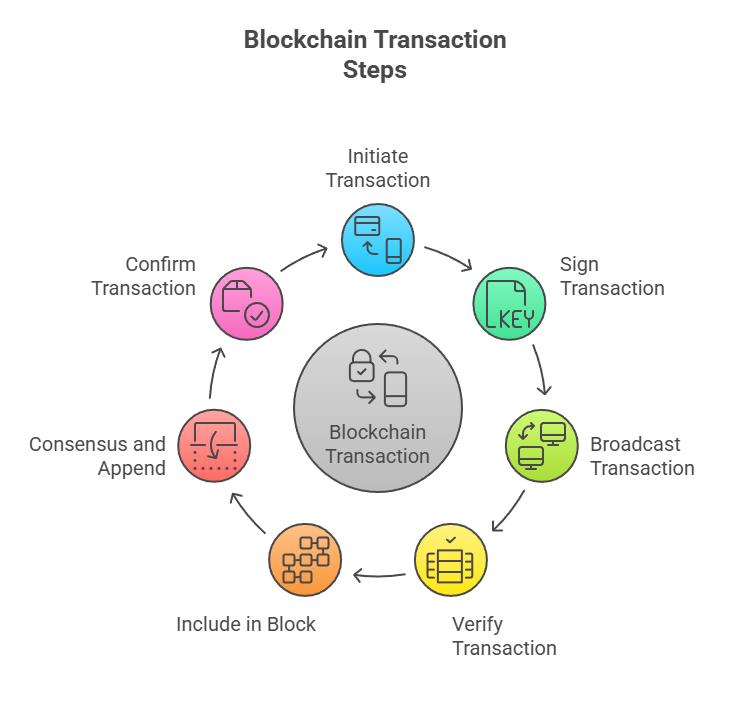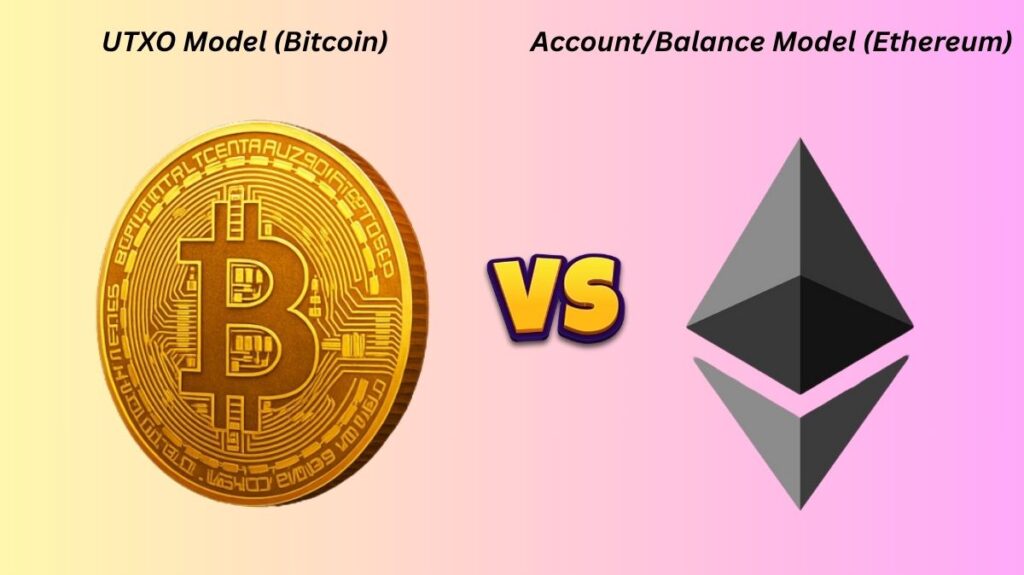Dive into the blockchain transaction Steps: uncover the essential stages a transaction undergoes, including wallet interaction, validation by nodes, inclusion in a block, and immutable recording on the chain.
Fundamentally, a transaction is the recording of an occurrence or the exchange of assets. It is a data packet that has been digitally signed and contains instructions or information about a conversation between participants. Imagine it as a user’s atomic write action that might change one or more entries in a global database.
You can also read The Blocks, Chaining, And Hashes Of Blockchain Architecture
What a Transaction Contains
Although the particular information in a transaction may differ based on how the blockchain technology is implemented, typical components consist of:
Sender and Recipient: Identifying the participants in the transaction. This includes the addresses of the sender (usually an externally controlled account) and the receiver in Ethereum. Bitcoin transactions include outputs (recipients) and inputs (money sources) from prior transactions.
Value or Data (Payload): Information carried by the transaction may include the quantity of bitcoin being transferred or information needed to activate a smart contract function. Transactions using Ethereum can transmit data, currency (ETH), or both.
Digital Signature: The sender uses their private key to cryptographically sign transactions. This guarantees the legitimacy of the transaction and demonstrates the sender’s possession of the assets or right to start the activity.
Nonce: A nonce, which serves as a unique identity and replay protection in systems like Ethereum, is a number that is increased by one for every transaction sent by an account.
Transaction Fee: To encourage miners or validators to include their transaction in a block, clients might choose to voluntarily tack on a charge. Usually, the creator of the block receives this money. Faster confirmation may result from higher costs, particularly in times of network congestion. The difference between total inputs and total outputs is the charge in Bitcoin.
Gas and Gas Price/Limit (Ethereum): The cost of computing is represented as gas in Ethereum. The amount of Wei (a small unit of Ether) that the sender is ready to pay for each unit of petrol is known as the petrol price. The maximum quantity of gas that the transaction is permitted to use is known as the gas limit. These have to do with transaction costs.
Timestamp: A timestamp that indicates the transaction’s recording time.
Blockchain Transaction Steps
There are many steps involved in processing a transaction on a blockchain:

Initiation and Creation: A transaction is started by a user or program, frequently via an interface or wallet software. Details of the transaction are created.
Signing: The sender’s private key is used to digitally sign the transaction.
Broadcasting: Usually, data-dissemination techniques such as the Gossip protocol are used to broadcast (propagate) the signed transaction to the blockchain network.
Verification and Validation: After receiving the transaction, nodes on the network verify it using the formalised data formats, validity standards, and protocol requirements of the network. Verifying the signature and making sure the sender has access to the assets mentioned (such as a sufficient balance or the appropriate UTXOs) are part of this process.
Inclusion in a Block: A pending transaction pool, often referred to as a memory pool or mempool, is where validated transactions are collected and usually stored. A subset of transactions is chosen from this pool by special players (such as miners or validators) to be included in a new block. Transaction costs are one example of a factor that may influence the choice.
Consensus and Appending: A consensus algorithm is used by participating nodes to reach an agreement over the legitimacy of the block that contains the transactions. The block is added to the current chain when a consensus has been obtained.
Confirmation/Commitment: A transaction is deemed completed or committed whenever it appears in a block that is successfully appended to the blockchain. Confidence in the transaction’s finality is boosted by the quantity of confirmations, or blocks appended to the block containing the transaction.
Transaction Models (UTXO vs. Account/Balance)

The underlying representation of assets and transactions is handled differently by various blockchains:
UTXO Model (Bitcoin): Assets are tracked as Unspent Transaction Outputs (UTXOs) in this paradigm. Existing UTXOs are used as inputs in a transaction, while new UTXOs are produced as outputs. The total of all the UTXOs you are able to spend is your balance. It is possible to trace the history of individual “coins” using this concept. Additionally, R3 Corda processes transactions using a UTXO-based mechanism like to that of Bitcoin.
Account/Balance Model (Ethereum): With a balance in each account, this strategy is more akin to traditional banking. The sender and recipient accounts’ balances are immediately updated by a transaction. Rather of monitoring certain unspent outputs, the value itself is updated.
Role and Purpose of Transactions
Blockchain processes depend on transactions, which have several uses:
- Transfer of Value/Ownership: Enabling peer-to-peer transfers of digital money or other assets between participants is the most popular use case. Cryptocurrency exchanges and the transfer of ownership of things such as titles, deeds, music, or artwork are examples of this.
- Executing Smart Contracts: Smart contract code that is encoded in the blockchain can be triggered by transactions. This enables business logic and automated actions to be carried out on the chain.
- Recording Events and Data: Events that take place on the network are documented via transactions. They may also be used to publish data on the blockchain in a permanent and public manner. This produces a history that can be independently audited and verified.
- State Transitions: Every transaction in a state machine that is driven by transactions, such as Ethereum, signifies a change in the blockchain’s state.
Relationship with Blocks and Chaining
The main material kept in blocks is transactions. In essence, a block is a container for a collection of verified transactions. A block’s transaction sequence may be dictated by factors such as transaction pool order and fees. Cryptographic hashes are then used to connect these blocks in a chain, with the hash of the preceding block included in the header of each block. The ledger is tamper-evident and unchangeable due to this chaining method and the cryptographic security of each block (e.g., a Merkle root of transactions).
Transaction Types
- Message Call Transactions: Used to initiate Ethereum contract execution or send communications between accounts.
- Contract Creation Transactions: Used to launch a new Ethereum smart contract, or establish a new contract account.
- Standard vs. Non-Standard (Bitcoin): Standard tests are used to analyze transactions, however if they pass validity checks, non-standard transactions are permitted.
- Public vs. Confidential/Private: Particularly in permissioned blockchains, transactions can be classified as secret or private (accessible only to those involved) or public (available to all participants). Both are supported by Quorum.
Transparency and Privacy
Transactions on public blockchains are often transparent, which means that all network users can see all of the details of the transaction. The transaction history itself is auditable, even if user identities may be pseudonymous (represented by account addresses rather than real names). One characteristic that helps make data more verifiable is its openness. However, privacy concerns may arise from the availability of transaction information. There are ways to improve privacy, such combining protocols (CoinSwap, TumbleBit) with private transactions (Pederson Commitments, Monero, etc.).
To sum up, transactions are the foundation of blockchain networks because they allow currency to be exchanged, automated programming to run, and events to be permanently recorded in a distributed ledger that is visible, verifiable, and essentially unchangeable.
